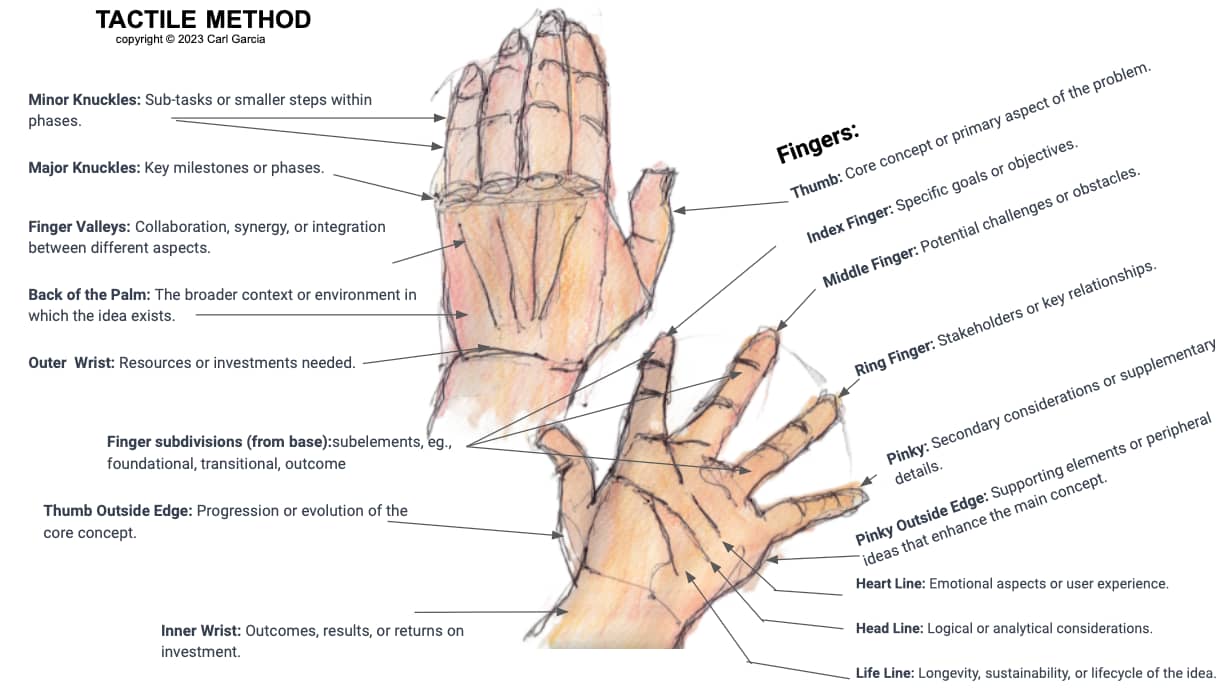Idea Definition
About: Tactile Idea Classifier
Description: A method and system that utilizes the natural features of human hands, including fingers, their subdivisions, palm lines, knuckles, back of fingers, finger valleys, thumb outside edge of hand, pinky outside edge of the hand, finger valleys, back of the palm, the wrist, to capture, classify, and recall ideas. This tactile approach offers a no-tech solution for ideation, allowing users to associate different facets of an idea with specific parts of their hands.
Components:
Fingers as Classifiers: Each finger represents a different facet of an idea, with further subdivisions using finger sections.
Palm Lines: The heart, head, life, and fate lines (if present) are used to delve deeper into emotional, logical, and other aspects of an idea.
The Back of the hand
Knuckles: High-Level Objectives or Milestones. The knuckles are prominent and can represent major goals or milestones that must be achieved. They can also symbolize the “hard” targets or essential building blocks of an idea.
Back of the Fingers: Supporting Strategies or Sub-Goals. The back of the fingers can be seen as supporting the main structure (the fingers themselves), so they could represent supporting strategies or secondary objectives that align with the main facets of an idea.
Finger Valleys (Spaces Between the Fingers): Connections or Relationships Between Facets. The valleys or spaces between the fingers can symbolize the connections or relationships between different facets of an idea. They can represent how different aspects interact, complement, or conflict with each other.
Outside Edge of the Hand (Pinky Side): Constraints or Limitations. The outside edge can symbolize the boundaries or limitations of an idea, project, or system. It can help define what is outside the scope or what constraints must be considered.
Outside Edge of the Hand (Thumb Side):Opportunities or Expansion Areas. The thumb side, being more flexible and robust, might represent opportunities for growth, expansion, or areas where there might be room for innovation or improvement.
Back of the Palm: Overall Theme or Vision. The back of the palm is a broad and central area that can symbolize the overarching theme, vision, or core philosophy guiding the entire idea or project.
Wrist: Foundations or Prerequisites. The wrist, being the connection to the arm, can represent the foundational elements, prerequisites, or underlying assumptions that the idea or project is built upon.
Potential Implementations:
- Hand-Scanning Pad: Translates hand positions into digital notes.
- Gesture Recognition Software: Interprets hand gestures to create digital idea maps.
- Haptic Feedback Gloves: Provides tactile reinforcement and records ideas for later download.
Areas of Concern:
- Usability: How intuitive is the system for new users? Is there a steep learning curve?
- Accuracy: How accurately can the system translate hand gestures into digital notes, especially in tech implementations?
- Scalability: How many ideas can one effectively classify using this method before it becomes too complex?
- Adaptability: How flexible is the system in accommodating different types of ideas or adapting to individual user preferences?
- Cultural Sensitivities: Are there any cultural or societal implications to consider, especially given that hand gestures and palmistry have specific meanings in various cultures?
- Tech Integration: How seamlessly can this method integrate with existing technology? Are there potential compatibility issues?
- Market Acceptance: Will the broader public see value in this method, especially in a tech-dominated world?
- Cost: If tech tools are developed, what would be the cost of production and market price?
- Safety and Privacy: In tech implementations, how will user data be protected? Are there concerns about biometric data collection?


3 thoughts on “Tactile Idea Classifier”